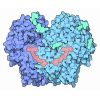+ Open data
Open data
- Basic information
Basic information
| Entry | Database: PDB / ID: 1jl9 | ||||||
|---|---|---|---|---|---|---|---|
| Title | Crystal Structure of Human Epidermal Growth Factor | ||||||
 Components Components | EPIDERMAL GROWTH FACTOR | ||||||
 Keywords Keywords |  SIGNALING PROTEIN / SIGNALING PROTEIN /  Dimerization / Dimerization /  Growth factor Growth factor | ||||||
| Function / homology |  Function and homology information Function and homology informationnegative regulation of secretion / positive regulation of hyaluronan biosynthetic process / negative regulation of cholesterol efflux / positive regulation of cerebellar granule cell precursor proliferation / cerebellar granule cell precursor proliferation / regulation of calcium ion import / positive regulation of protein localization to early endosome / regulation of protein localization to cell surface / positive regulation of epithelial tube formation / positive regulation of ubiquitin-dependent protein catabolic process ...negative regulation of secretion / positive regulation of hyaluronan biosynthetic process / negative regulation of cholesterol efflux / positive regulation of cerebellar granule cell precursor proliferation / cerebellar granule cell precursor proliferation / regulation of calcium ion import / positive regulation of protein localization to early endosome / regulation of protein localization to cell surface / positive regulation of epithelial tube formation / positive regulation of ubiquitin-dependent protein catabolic process / regulation of receptor signaling pathway via JAK-STAT / Inhibition of Signaling by Overexpressed EGFR / EGFR interacts with phospholipase C-gamma / PLCG1 events in ERBB2 signaling / ERBB2-EGFR signaling pathway / NFE2L2 regulating tumorigenic genes /  epidermal growth factor receptor binding / ERBB2 Activates PTK6 Signaling / branching morphogenesis of an epithelial tube / Signaling by EGFR / epidermal growth factor receptor binding / ERBB2 Activates PTK6 Signaling / branching morphogenesis of an epithelial tube / Signaling by EGFR /  transmembrane receptor protein tyrosine kinase activator activity / Signaling by ERBB4 / ERBB2 Regulates Cell Motility / positive regulation of receptor internalization / PI3K events in ERBB2 signaling / Estrogen-dependent nuclear events downstream of ESR-membrane signaling / mammary gland alveolus development / positive regulation of DNA binding / GAB1 signalosome / positive regulation of phosphorylation / Signaling by ERBB2 / ERK1 and ERK2 cascade / GRB2 events in EGFR signaling / SHC1 events in EGFR signaling / GRB2 events in ERBB2 signaling / positive regulation of endothelial cell proliferation / SHC1 events in ERBB2 signaling / guanyl-nucleotide exchange factor activity / positive regulation of mitotic nuclear division / positive regulation of endothelial cell migration / platelet alpha granule lumen / positive regulation of peptidyl-threonine phosphorylation / epithelial cell proliferation / NOTCH3 Activation and Transmission of Signal to the Nucleus / EGFR downregulation / clathrin-coated endocytic vesicle membrane / Signaling by ERBB2 TMD/JMD mutants / transmembrane receptor protein tyrosine kinase activator activity / Signaling by ERBB4 / ERBB2 Regulates Cell Motility / positive regulation of receptor internalization / PI3K events in ERBB2 signaling / Estrogen-dependent nuclear events downstream of ESR-membrane signaling / mammary gland alveolus development / positive regulation of DNA binding / GAB1 signalosome / positive regulation of phosphorylation / Signaling by ERBB2 / ERK1 and ERK2 cascade / GRB2 events in EGFR signaling / SHC1 events in EGFR signaling / GRB2 events in ERBB2 signaling / positive regulation of endothelial cell proliferation / SHC1 events in ERBB2 signaling / guanyl-nucleotide exchange factor activity / positive regulation of mitotic nuclear division / positive regulation of endothelial cell migration / platelet alpha granule lumen / positive regulation of peptidyl-threonine phosphorylation / epithelial cell proliferation / NOTCH3 Activation and Transmission of Signal to the Nucleus / EGFR downregulation / clathrin-coated endocytic vesicle membrane / Signaling by ERBB2 TMD/JMD mutants /  growth factor activity / Constitutive Signaling by EGFRvIII / positive regulation of MAP kinase activity / Signaling by ERBB2 ECD mutants / epidermal growth factor receptor signaling pathway / Signaling by ERBB2 KD Mutants / Downregulation of ERBB2 signaling / positive regulation of canonical Wnt signaling pathway / Constitutive Signaling by Aberrant PI3K in Cancer / positive regulation of peptidyl-tyrosine phosphorylation / Cargo recognition for clathrin-mediated endocytosis / Platelet degranulation / PIP3 activates AKT signaling / Constitutive Signaling by Ligand-Responsive EGFR Cancer Variants / growth factor activity / Constitutive Signaling by EGFRvIII / positive regulation of MAP kinase activity / Signaling by ERBB2 ECD mutants / epidermal growth factor receptor signaling pathway / Signaling by ERBB2 KD Mutants / Downregulation of ERBB2 signaling / positive regulation of canonical Wnt signaling pathway / Constitutive Signaling by Aberrant PI3K in Cancer / positive regulation of peptidyl-tyrosine phosphorylation / Cargo recognition for clathrin-mediated endocytosis / Platelet degranulation / PIP3 activates AKT signaling / Constitutive Signaling by Ligand-Responsive EGFR Cancer Variants /  Clathrin-mediated endocytosis / PI5P, PP2A and IER3 Regulate PI3K/AKT Signaling / RAF/MAP kinase cascade / Clathrin-mediated endocytosis / PI5P, PP2A and IER3 Regulate PI3K/AKT Signaling / RAF/MAP kinase cascade /  angiogenesis / Extra-nuclear estrogen signaling / positive regulation of MAPK cascade / angiogenesis / Extra-nuclear estrogen signaling / positive regulation of MAPK cascade /  receptor ligand activity / positive regulation of phosphatidylinositol 3-kinase/protein kinase B signal transduction / positive regulation of cell migration / lysosomal membrane / receptor ligand activity / positive regulation of phosphatidylinositol 3-kinase/protein kinase B signal transduction / positive regulation of cell migration / lysosomal membrane /  calcium ion binding / positive regulation of cell population proliferation / positive regulation of gene expression / positive regulation of DNA-templated transcription / calcium ion binding / positive regulation of cell population proliferation / positive regulation of gene expression / positive regulation of DNA-templated transcription /  extracellular space / extracellular exosome / extracellular region / extracellular space / extracellular exosome / extracellular region /  plasma membrane plasma membraneSimilarity search - Function | ||||||
| Biological species |   Homo sapiens (human) Homo sapiens (human) | ||||||
| Method |  X-RAY DIFFRACTION / X-RAY DIFFRACTION /  MIR / Resolution: 3 Å MIR / Resolution: 3 Å | ||||||
 Authors Authors | Lu, H.S. / Chai, J.J. / Li, M. / Huang, B.R. / He, C.H. / Bi, R.C. | ||||||
 Citation Citation |  Journal: J.Biol.Chem. / Year: 2001 Journal: J.Biol.Chem. / Year: 2001Title: Crystal structure of human epidermal growth factor and its dimerization Authors: Lu, H.S. / Chai, J.J. / Li, M. / Huang, B.R. / He, C.H. / Bi, R.C. | ||||||
| History |
|
- Structure visualization
Structure visualization
| Structure viewer | Molecule:  Molmil Molmil Jmol/JSmol Jmol/JSmol |
|---|
- Downloads & links
Downloads & links
- Download
Download
| PDBx/mmCIF format |  1jl9.cif.gz 1jl9.cif.gz | 22.7 KB | Display |  PDBx/mmCIF format PDBx/mmCIF format |
|---|---|---|---|---|
| PDB format |  pdb1jl9.ent.gz pdb1jl9.ent.gz | 17.7 KB | Display |  PDB format PDB format |
| PDBx/mmJSON format |  1jl9.json.gz 1jl9.json.gz | Tree view |  PDBx/mmJSON format PDBx/mmJSON format | |
| Others |  Other downloads Other downloads |
-Validation report
| Arichive directory |  https://data.pdbj.org/pub/pdb/validation_reports/jl/1jl9 https://data.pdbj.org/pub/pdb/validation_reports/jl/1jl9 ftp://data.pdbj.org/pub/pdb/validation_reports/jl/1jl9 ftp://data.pdbj.org/pub/pdb/validation_reports/jl/1jl9 | HTTPS FTP |
|---|
-Related structure data
| Similar structure data |
|---|
- Links
Links
- Assembly
Assembly
| Deposited unit | 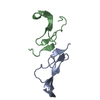
| ||||||||
|---|---|---|---|---|---|---|---|---|---|
| 1 |
| ||||||||
| Unit cell |
|
- Components
Components
| #1: Protein |  / EGF / EGFMass: 5958.676 Da / Num. of mol.: 2 / Fragment: RESIDUES 1-51 Source method: isolated from a genetically manipulated source Source: (gene. exp.)   Homo sapiens (human) / Production host: Homo sapiens (human) / Production host:   Saccharomyces cerevisiae (brewer's yeast) / References: UniProt: P01133 Saccharomyces cerevisiae (brewer's yeast) / References: UniProt: P01133#2: Water | ChemComp-HOH / |  Water Water |
|---|
-Experimental details
-Experiment
| Experiment | Method:  X-RAY DIFFRACTION / Number of used crystals: 1 X-RAY DIFFRACTION / Number of used crystals: 1 |
|---|
- Sample preparation
Sample preparation
| Crystal | Density Matthews: 3.98 Å3/Da / Density % sol: 69.08 % | ||||||||||||||||||||||||||||||
|---|---|---|---|---|---|---|---|---|---|---|---|---|---|---|---|---|---|---|---|---|---|---|---|---|---|---|---|---|---|---|---|
Crystal grow | Temperature: 293 K / Method: vapor diffusion, hanging drop / pH: 8.1 Details: magnesium chloride, Bicine, CYMAL-3, sodium azide, pH 8.1, VAPOR DIFFUSION, HANGING DROP, temperature 293K | ||||||||||||||||||||||||||||||
| Crystal grow | *PLUS Temperature: 291 K | ||||||||||||||||||||||||||||||
| Components of the solutions | *PLUS
|
-Data collection
| Diffraction source | Source:  ROTATING ANODE / Site: ROTATING ANODE / Site:  APS APS  / Type: RIGAKU RU200 / Type: RIGAKU RU200 |
|---|---|
| Radiation | Protocol: SINGLE WAVELENGTH / Monochromatic (M) / Laue (L): M / Scattering type: x-ray |
| Radiation wavelength | Relative weight: 1 |
| Reflection | Resolution: 3→100 Å / Num. all: 21097 / Num. obs: 4040 / % possible obs: 99 % / Rmerge(I) obs: 0.104 |
| Reflection shell | Resolution: 3→3.11 Å / % possible all: 96.8 |
| Reflection | *PLUS Highest resolution: 3 Å / Lowest resolution: 100 Å / % possible obs: 99 % / Num. measured all: 21097 |
- Processing
Processing
| Software |
| ||||||||||||||||||
|---|---|---|---|---|---|---|---|---|---|---|---|---|---|---|---|---|---|---|---|
| Refinement | Method to determine structure : :  MIR / Resolution: 3→8 Å / Isotropic thermal model: Isotropic / Cross valid method: THROUGHOUT / σ(F): 2 / Stereochemistry target values: Engh & Huber / MIR / Resolution: 3→8 Å / Isotropic thermal model: Isotropic / Cross valid method: THROUGHOUT / σ(F): 2 / Stereochemistry target values: Engh & Huber /
| ||||||||||||||||||
| Refinement step | Cycle: LAST / Resolution: 3→8 Å
| ||||||||||||||||||
| Refine LS restraints |
| ||||||||||||||||||
| Software | *PLUS Name:  X-PLOR / Version: 3.851 / Classification: refinement X-PLOR / Version: 3.851 / Classification: refinement | ||||||||||||||||||
| Refinement | *PLUS Highest resolution: 3 Å / Lowest resolution: 8 Å / σ(F): 2 / % reflection Rfree: 10 % / Rfactor obs: 0.231 | ||||||||||||||||||
| Solvent computation | *PLUS | ||||||||||||||||||
| Displacement parameters | *PLUS |
 Movie
Movie Controller
Controller



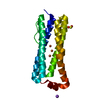
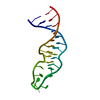
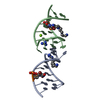
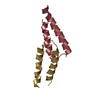
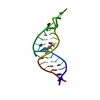

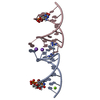

 PDBj
PDBj









